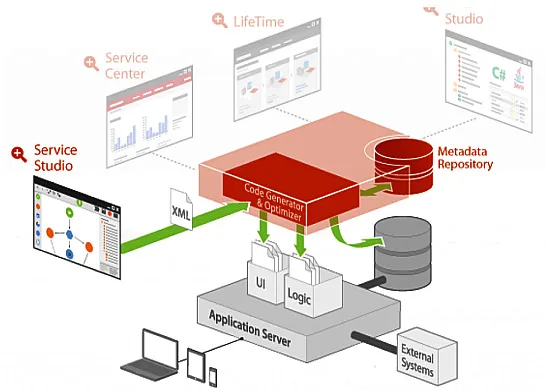
Rapid Application Development with OutSystems
- 402 pages
- English
- ePUB (mobile friendly)
- Available on iOS & Android
Rapid Application Development with OutSystems
About this book
Discover best practices in this illustrated guide to create simple, robust, and scalable software solutions quickly and securely, and focus on what's important - the business and the end customer
Key Features
- Discover strategies and tips for low-code and no-code development with the help of useful examples in this full-color guide
- Build enterprise-scale reactive web and mobile applications
- Explore the benefits of low-code development
Book Description
OutSystems is a software development platform that speeds up the build phase by abstracting code and making almost everything visual. This means replacing textual language with visual artifacts that avoid lexical errors and speed up code composition using accelerators and predefined templates.The book begins by walking you through the fundamentals of the technology, along with a general overview of end-to-end web and mobile software development. You'll learn how to configure your personal area in the cloud and use the OutSystems IDE to connect with it. The book then shows you how to build a web application based on the best architectural and developmental practices in the market, and takes the same approach for the mobile paradigm. As you advance, you'll find out how to develop the same application, and the great potential of reusing code from one paradigm in another and the symbiosis between them is showcased.The only application that'll differ from the application in the exercise is the one used in business process technology (BPT), with a focus on a common market use case.By the end of this OutSystems book, you'll be able to develop enterprise-level applications on the web and mobile, integrating them with third parties and other systems on the market. You'll also understand the concepts of performance, security, and software construction and be able to apply them effectively.
What you will learn
- Get to grips with the OutSystems infrastructure
- Develop reactive web and mobile applications in OutSystems using best practices in Service Studio
- Define and design Architecture Canvas (3-Layer Canvas) for your applications
- Integrate with external systems in OutSystems
- Enhance applications with BPT
- Manage and monitor your applications in the OutSystems infrastructure
Who this book is for
This book is for back-end developers, tech leaders, UX/UI developers, frontend developers, (in general, full-stack developers), tech companies, and enterprises looking to learn how to develop web and mobile software quickly and disruptively by leveraging OutSystems, one of the most low-code platforms in the market. An IT background is not mandatory; however, experience in SQL, JavaScript, HTML, CSS, and C# is required to get started with this book.
]]>
Frequently asked questions
- Essential is ideal for learners and professionals who enjoy exploring a wide range of subjects. Access the Essential Library with 800,000+ trusted titles and best-sellers across business, personal growth, and the humanities. Includes unlimited reading time and Standard Read Aloud voice.
- Complete: Perfect for advanced learners and researchers needing full, unrestricted access. Unlock 1.4M+ books across hundreds of subjects, including academic and specialized titles. The Complete Plan also includes advanced features like Premium Read Aloud and Research Assistant.
Please note we cannot support devices running on iOS 13 and Android 7 or earlier. Learn more about using the app.
Information
Section 1: OutSystems 101
- Chapter 1, Exploring the OutSystems Platform
- Chapter 2, Components, Tools, and Capabilities
- Chapter 3, Starting Work with OutSystems
Chapter 1: Exploring the OutSystems Platform
- Platform overview
- OutSystems factory options
- External tools, components, and support
Platform overview
- Personal Environment: OutSystems offers a small software factory free of charge (in the cloud) so that we can do our exercises, tests, and small applications without a productive context.
- Enterprise: Licensed software factories for companies. It can exist in the cloud (AWS), private cloud, or on the company's own physical servers (on-premises). Enterprise versions can exist in different types of licensing and are paid.
- Development
- Quality Assurance
- Production
Platform server
- Compile
- Deploy
- Manage
- Run
- Monitor

Table of contents
- Rapid Application Development with OutSystems
- Foreword
- Contributors
- About the author
- About the reviewers
- Preface
- Section 1: OutSystems 101
- Chapter 1: Exploring the OutSystems Platform
- Chapter 2: Components, Tools, and Capabilities
- Chapter 3: Starting Work with OutSystems
- Section 2: The Magical Path of the Backend
- Chapter 4: Using Your Modules to Simplify and Encapsulate Your Code
- Chapter 5: Modeling Data by Using Entities
- Chapter 6: Server-Side Logic
- Chapter 7: Exceptions Handling
- Section 3: Create Value and Innovate with the Frontend
- Chapter 8: Reactive UI Development
- Chapter 9: Using Mobile Patterns for Fast Mobile UI Development
- Chapter 10: Client-Side Logic
- Chapter 11: Local Storage and Data Synchronization
- Chapter 12: Debugging and Troubleshooting Mobile and Reactive Web Apps
- Section 4: Extensibility and Complexity of the OutSystems Platform
- Chapter 13: Designing the Architecture of Your OutSystems Applications
- Chapter 14: Integrating OutSystems with Your Ecosystem
- Chapter 15: BPT Processes and Timers – Asynchronous Tools in OutSystems
- Other Books You May Enjoy